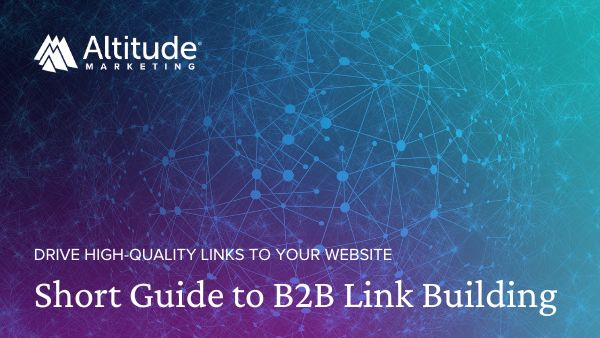The more visible your website is, the more successful your lead-generation efforts will be. While many factors contribute to your site’s visibility, building high-quality backlinks (a.k.a. B2B link building) plays a key role. This blog covers how to drive high-quality links to your site.
Let’s face it: Link building can be one of the more intimidating parts of a sound SEO strategy.
While many factors for “good SEO” and site visibility are directly in your control (e.g., creating high-quality content or building a high-performing website), getting high-quality backlinks isn’t always in your control.
The good news is there are steps you can take to make sure your website is getting as many high-quality backlinks as possible.
So, if you’re wondering where to start (or what we’re even talking about), this blog is for you. Here’s what we’ll cover:
- What is B2B link building?
- Why is link building important for B2B companies?
- What makes a backlink good?
- What are the main ways marketers build backlinks?
- 8 effective backlinking tactics

What Is B2B Link Building?
B2B link building is the process of getting other websites to link back to yours.
Link building involves all areas of marketing. You can build high-quality backlinks by:
- Creating high-quality content
- Emailing sources
- Finding unlinked brand mentions or relevant broken links
- Earning media placements and ensuring they link back
- Sharing content on social media
Why Is Linking Building Important for B2B Companies?
Building a reserve of high-quality backlinks to your site can increase your site’s authority. That increase in authority leads to an increase in visibility. That means more traffic to your site.
The more traffic your site gets, the more you’ll be able to drive conversions and generate qualified leads.
Plus, much of the work you do to get those good backlinks will result in high-quality content that will help you establish credibility, build trust and attract new customers.
That trust and credibility will also help make other marketing efforts more successful. Think of the user journey:
- A user clicks a link on a credible website
- They land on a high-quality piece of content on your blog
- They like what they read and remember your name
- They browse LinkedIn and see one of your ads
- They click and fill out the lead-gen form to download an asset
- You now have an MQL
Obviously, not every user journey is this clean, but the point is getting good backlinks is an important part of a greater whole.
What Makes a Backlink Good?
A good backlink is one that comes from a website that has a high domain authority and relevance to your industry. The link should be placed in the body of the page with relevant anchor text and proper link attributes.
Here’s what that all means.
High Domain Authority
Authority is an SEO concept that refers to the perceived credibility of a website. It’s calculated as a score out of 100.
A link from a website with a high authority score is more valuable than one with a lower authority score.
In practical terms, a link from a major news outlet like The New York Times will be more valuable than one from a random blogger. Any .edu link is king.
Relevance
Google takes subject matter relevance into account when ascribing value to backlinks.
That means links coming from sites that are relevant to your industry or subject matter are better than links coming from sites unrelated to your subject matter.
For example, you run a biotech company, and you get a link back from a high-authority website about brewing beer. Great! But it probably won’t do much for your website’s rankings.
Placement, Anchor Text & Attributes
The placement of a link matters. Google looks at the probability that a user will click on the link. That means links in the sidebar or low on the page are less valuable than those placed high up in the body of the article.
Google also looks at anchor text – the clickable text that appears in a hyperlink. This text is important because it tells users what to expect when they click. In the eyes of Google, the more descriptive and clear the anchor text is, the better the link quality.
There are ways developers can tag hyperlinks in the HTML of a webpage. These are called link attributes. Google looks to these attributes for hints on how to interpret the link.
If a link is posted without attributes, it’s interpreted as a “follow” link, which implies endorsement and passes along ranking credit. “Nofollow” links, on the other hand, imply no endorsement and do not pass along ranking credit.
This doesn’t mean “nofollow” links are useless, but “follow” links are better for your site’s SEO rankings.
What are the Main Ways Marketers Build Backlinks?
There are three main ways to build backlinks. You can add them. You can ask for them. You can earn them.
Adding Backlinks
You can always add links to your site on your social media profiles, blog comment sections, directory sites and forums. However, these are usually deemed some of the lowest quality links that won’t impact your rankings because you created them.
Asking for Backlinks
Another way you can add links to your site is by directly asking for them.
Identify potential sites where your content would be a good fit. Usually, they will have an info email or contact page. Send them an email and ask for a link.
Important to note: you can’t ask them to just link to your site. You need to provide them with high-quality content that will be useful for their users. Blog posts, eBooks, guides, infographics, or original research and data all work.
Earning Backlinks
Sometimes, other sites will link to yours without asking. This best-case scenario is hard to predict, so don’t bank on it.
However, if you want to increase your odds of earning backlinks, create high-quality, shareable content. In-depth guides, novel research, videos and visual content are all great content types for earning backlinks.
8 Effective B2B Link Building Tactics
#1. Create Valuable Content
The most important part of link building is having high-quality, valuable content people want to link to. Remember, the best links come from authoritative sites. Those sites won’t ruin their reputation by linking to flimsy content.
Great content is the foundation of a successful backlinking initiative.
#2. Targeted Outreach
Compile a list of websites relevant to your industry, and start sending emails.
This type of outreach, especially for industry publications and blogs, is common, so your email asking them to link to a piece of content won’t be a weird ask. Unfortunately, there’s a high probability they won’t respond.
However, if you want a better chance at landing that backlink, do your research. Find a piece of content that you’ve created. Then, find a place on their website where it will make sense to link it.
Include that information in the email and make sure it’s abundantly clear how this content and link benefits their readers.
#3. Guest Posting
Another great way to get backlinks is to contribute content to an industry-relevant blog or publication site with high authority.
This also goes back to outreach and networking. As you form those relationships, you’ll find ways to naturally pitch guest post blogs that can lead to great backlinks.
#4. Press Releases
Did your company recently expand? Release a new version of your software? Added new integrations and features? Did you win an industry award?
These reasons and more are great opportunities to distribute a press release that could get picked up by industry news outlets
#5. Social Media
Obviously, you should be promoting content on your social media profiles. But you can go a step further and engage and network with others in your industry. They’ll see your content and if it’s useful, they may share it, too.
#6. Broken Link Building
Finding a broken link on another site can be a quick win-win for you and the owner of that other site.
As soon as you find one, notify the site owner and provide your piece of content as a replacement. They’ll be happy to replace that broken link, and you’ll get a high-quality backlink to your content.
#7. Industry Directories and Associations
Research relevant industry directories and make sure your site gets listed with them. By that same token, joining relevant membership organizations is another quick way to get your company a high-quality link.
#8. Content Syndication
Another quick way to get links out there is sharing content and relevant blog articles on LinkedIn, Medium or other industry-specific forums. The real advantage here is that other authoritative sites for syndication could pick up your article.
Final Thoughts: If you want quality B2B backlinks, you need quality content.
Link building is a vital component of any B2B SEO strategy. As you create high-quality content and build relationships with industry thought leaders and publications, you’ll see a boost in your SEO rankings and traffic.
But it all starts with great content. When you start a B2B link building strategy, you won’t see immediate results. However, if you stick with it, you’ll be surprised at how much more traffic and authority your website will get.




